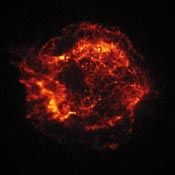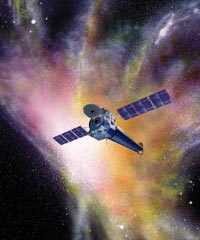Main Menu · Search · Current Issue · Contact · Archives · Centennial · Letters to the Editor · FAQs

 Chandra's first image: a supernova remnant, Cassiopeia A. The bright dot near the center may be a neutron star or black-hole remnant of the explosion that produced the supernova. Photograph courtesy of NASA |
This summer, a Harvard team watched as two decades of work flew off into space: the space shuttle Columbia launched the Chandra X-ray Observatory into orbit. Only 34 days later, a panel of beaming scientists announced that the images the telescope was transmitting to Earth had already exceeded their hopes. The first picture showed not just the expected billowy ring of stardust and gases emanating from an exploded star, but revealed a small, bright dot in the center of the ring that could amount to a major astronomical discovery. "It may be the black hole or the neutron star formed at the time of the explosion," explains Harvey Tananbaum, director of the Chandra X-ray Center, which developed the $2.7-billion telescope at the Smithsonian Astrophysical Observatory, part of the Harvard-Smithsonian Center for Astrophysics, of which Tananbaum is associate director. The discovery, he said, "is very tantalizing" because it could tell astronomers what happened to the original star, whose fiery end became visible on Earth around the time Isaac Newton wrote his treatise on optics, about 300 years ago.
The Chandra X-ray Observatory, as the orbiting space telescope and its related complex of instruments are known, is not Isaac Newton's telescope. Named for the late Indian-American astrophysicist Subrahmanyan Chandrasekhar, a Nobel laureate whose nickname, Chandra, means "luminous" or "moon" in Sanskrit, the orbiting observatory can penetrate astronomical distances Newton only imagined: the supernova cited lies far beyond the range of the human eye, about 10,000 light years from earth--each light year equaling six trillion miles. Other telescopes, including the powerful Hubble Space Telescope, share a comparable ability to see very distant objects. But the supernova is so hot, with temperatures soaring into the millions of degrees, that it does not emit visible light, but x-rays--which are invisible to even the most powerful optical telescopes like the Hubble. "Both Hubble and Chandra see very distant objects, but they see them differently," explains Christine Jones '71, Ph.D. '74, an astrophysicist who has worked on the Chandra team since 1984. "For example, in a cluster of galaxies, Hubble looks at individual galaxies, while Chandra sees the superheated gases between them."
 An artist's rendering of the Chandra observatory. Image courtesy of NASA |
Depending on its temperature, matter emits electromagnetic radiation (including visible light) in different wavelengths--from radio waves at the coolest end of the spectrum to x-rays and gamma rays at the hottest. For each kind of radiation, astronomers have devised a corresponding kind of telescope--each able to see different objects, or different features of the same objects. The earth's atmosphere absorbs x-rays; hence, x-ray telescopes must observe the universe from space.
Since the National Aeronautics and Space Administration (NASA) launched the first x-ray telescope in the early 1970s, the technology has revealed or confirmed the existence of phenomena never before seen, including black holes. Three other x-ray missions are still operating, but none shares Chandra's capabilities. Thanks to an advanced focusing system that consists of four sets of nested, cylindrical mirrors polished to a smoothness of a few atoms, Chandra provides 10 times the resolution of any previous x-ray telescope, detecting objects more than twice as far away and producing images with five times greater detail. If its power were built into the human eye, for example, we could read a newspaper from a half-mile away.
Jones and other astrophysicists hope that the images from Chandra will allow them to peer into black holes; to glimpse the process by which the elements necessary for life are forged within stars and blown out into space; and to examine the turbulent forces within giant galaxy clusters. "Galaxy clusters are the largest known objects in the universe, and they're filled with dark matter," Jones says. "X-ray images can tell us how much dark matter there is, and how it's distributed." These secrets, in turn, may put the reigning theories of the universe to the test; until we know the nature of "dark matter"--which is thought to make up 75 to 99 percent of the universe--how do we know what the universe is? The new telescope may also illuminate such astronomical riddles as how a black hole warps time and space.
 Above, images of the Crab Nebula from optical, infrared, and radio telescopes. Photographs courtesy of NASA |
To find out, Chandra is zooming around the earth, soaring--at the farthest point of its orbit--about one-third of the distance to the moon. NASA staff direct and monitor its every move from the flight-operations center--a few modest-looking, computer-filled rooms in a Cambridge office building.
The object of their attention represents years of research and interagency negotiation by Tananbaum and his team, who operate the project for NASA's Marshall Space Flight Center in Huntsville, Alabama. Now--given the promising first images--what was originally planned and funded as a five-year mission could extend to decades, as the world's top astronomers jockey among themselves to propose new projects. Competitive peer review will determine what Chandra focuses on next, but it will likely include nearby stars and galaxies as well as the most distant quasars and galaxy clusters. With Chandra, Tananbaum says, "We're going to the edge of the universe."
~ Jane Roy Brown